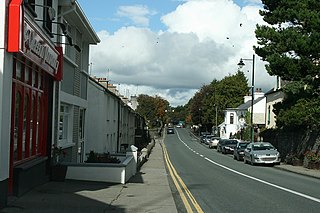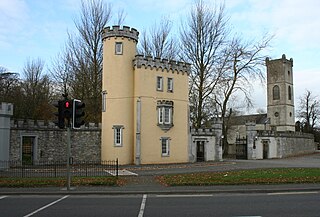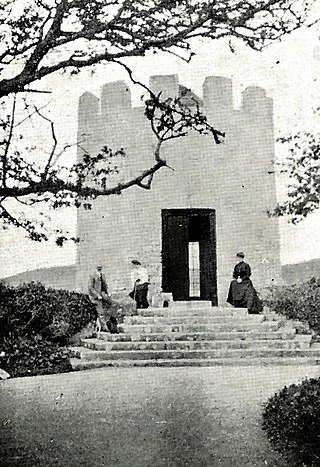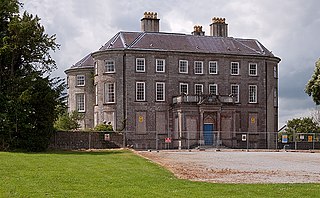
County Laois is a county in Ireland. It is part of the Eastern and Midland Region and in the province of Leinster. It was known as Queen's County from 1556 to 1922. The modern county takes its name from Loígis, a medieval kingdom. Historically, it has also been known as County Leix.

Viscount Ashbrook is a title in the Peerage of Ireland. It was created in 1751 for Henry Flower, 2nd Baron Castle Durrow. The title of Baron Castle Durrow, in the County of Kilkenny, had been created in the Peerage of Ireland in 1733 for his father William Flower. He was a Colonel in the Army and also represented County Kilkenny and Portarlington in the Irish House of Commons. He was praised by Jonathan Swift as "a gentleman of very great sense and wit". As of 2022, the titles are held by the eleventh Viscount, who succeeded his father in 1995.
Ballyfin is a small village and parish in County Laois, Ireland. Located in the Slieve Bloom Mountains, the village is in the midlands of Ireland. It is around 8 km west of Portlaoise, on the R423 road between Mountrath and Mountmellick.

Abbeyleix is a town in County Laois, Ireland, located around 14 kilometres (8.7 mi) south of the county town of Portlaoise. Abbelyleix is in a civil parish of the same name.

Glassan or Glasson, also the Village of the Roses, is a small village in rural County Westmeath, Ireland. It is 10 km (6.2 mi) north of Athlone, on the N55 national secondary road, not far from the shores of Lough Ree.

Emo Court, located near the village of Emo in County Laois, Ireland, is a large neo-classical mansion. Architectural features of the building include sash-style windows, pavilions, a balustrade, a hipped roof, and large dome.
Sir John Temple was an Irish politician, Speaker of the Irish House of Commons and Attorney General for Ireland. He was the great-great-grandfather of the distinguished statesman Henry John Temple, 3rd Viscount Palmerston. His descendants in the female line include the famous poet Lord Byron.

Durrow is a village located in south-east County Laois, Ireland. Bypassed by the M8 motorway on 28 May 2010, the village is located on the R639 road at its junction with the N77. The River Erkina flows through Durrow and joins the River Nore about 1.5 km east of the village.

Cullahill or Cullohill is a small village situated on the R639 road in County Laois, Ireland. Cullahill takes its name from an ancient forest that covered Cullahill Mountain and extended down to Cullahill Castle.

The R639 road is one of Ireland's regional roads. Once designated the N8 national primary road, it was reclassified in stages as the R639 following the progressive opening of sections of the M8 motorway, which rendered the single carriageway N8 redundant as a national primary road. By-passed sections of the old N8 were generally reclassified as R639 as soon as a new section of M8 opened, thereby increasing the length of the R639. With the completion of the M8 on 28 May 2010, the R639 now stretches from Durrow, County Laois to Cork, running through counties Laois, Kilkenny, Tipperary, Limerick and Cork.

Rostellan is a civil parish, townland and village in the historical Barony of Imokilly, County Cork, Ireland. An electoral division of the same name forms part of the Cork East Dáil constituency. For census purposes, the village of Rostellan is combined with the neighbouring villages of Farsid and Aghada. As of the 2011 census, the combined settlement of Aghada-Farsid-Rostellan had a population of 1,015 people.
William Flower, 1st Baron Castle Durrow PC (Ire) was an Anglo-Irish peer and politician.
The High Sheriff of Queen's County was the British Crown's judicial representative in Queen's County, Ireland, Ireland from the 16th century until 1922, when the office was abolished in the new Free State and replaced by the office of Offaly County Sheriff. The sheriff had judicial, electoral, ceremonial and administrative functions and executed High Court Writs. In 1908, an Order in Council made the Lord-Lieutenant the Sovereign's prime representative in a county and reduced the High Sheriff's precedence. However, the sheriff retained his responsibilities for the preservation of law and order in the county. The usual procedure for appointing the sheriff from 1660 onwards was that three persons were nominated at the beginning of each year from the county and the Lord Lieutenant then appointed his choice as High Sheriff for the remainder of the year. Often the other nominees were appointed as under-sheriffs. Sometimes a sheriff did not fulfil his entire term through death or other event and another sheriff was then appointed for the remainder of the year. The dates given hereunder are the dates of appointment. All addresses are in Queen's County unless stated otherwise.
Robert Thomas Flower, 8th Viscount Ashbrook was an Anglo-Irish peer, Lieutenant-Colonel in the British Army, and inventor.
Favour Royal is a manor and estate in County Tyrone, Northern Ireland. It is located in the townland of Favor Royal Demesne, around 3 miles (4.8 km) east of Augher, close to the Irish border. It is within the parish of Errigal-Trough which is part of the historic barony of Clogher.

Lucan Manor is a Georgian-Palladian house and estate in Lucan, County Dublin. A manor house, it is remembered particularly for its association with the Sarsfield family. A castle or house has been recorded on the site since at least the 12th century.

Doneraile Court is a late-17th century country house near the town of Doneraile in County Cork, Ireland. It stands in 160 hectares of walled parkland known as Doneraile Park or Doneraile Estate. The house remained the seat of the St Leger family from the time of construction until the mid-20th century. The park, which is managed by the Office of Public Works (OPW), is open all year with free admission. As of 2023, Donerail Park was the most visited free tourist attraction in County Cork, and the fifth most visited OPW site in the country.
John Jeffreys (c.1623-1689) was a Welsh soldier, landowner and politician, much of whose career was spent in Ireland. He fought in the English Civil War on the Royalist side, and later sat in the Houses of Commons of both England and Ireland. He is best remembered as the first Master of the Royal Hospital Kilmainham.
Sir William Flower (c.1600–c.1682) was an Anglo-Irish soldier, politician and landowner of the seventeenth century. He fought for Oliver Cromwell during the English Civil War but was imprisoned as a suspected Royalist, a suspicion later confirmed by the rewards he received after the Restoration of Charles II. His descendants still hold the titles Viscount Ashbrook and Baron Castle Durrow.

Killiney Castle, also known as Mount Malpas, Rocksborough, or Loftus Hill, and now known as Fitzpatrick Castle Hotel, is an 18th-century manor house near Killiney in County Dublin, Ireland. Subsequently converted into a hotel, it has operated as one since 1971.














